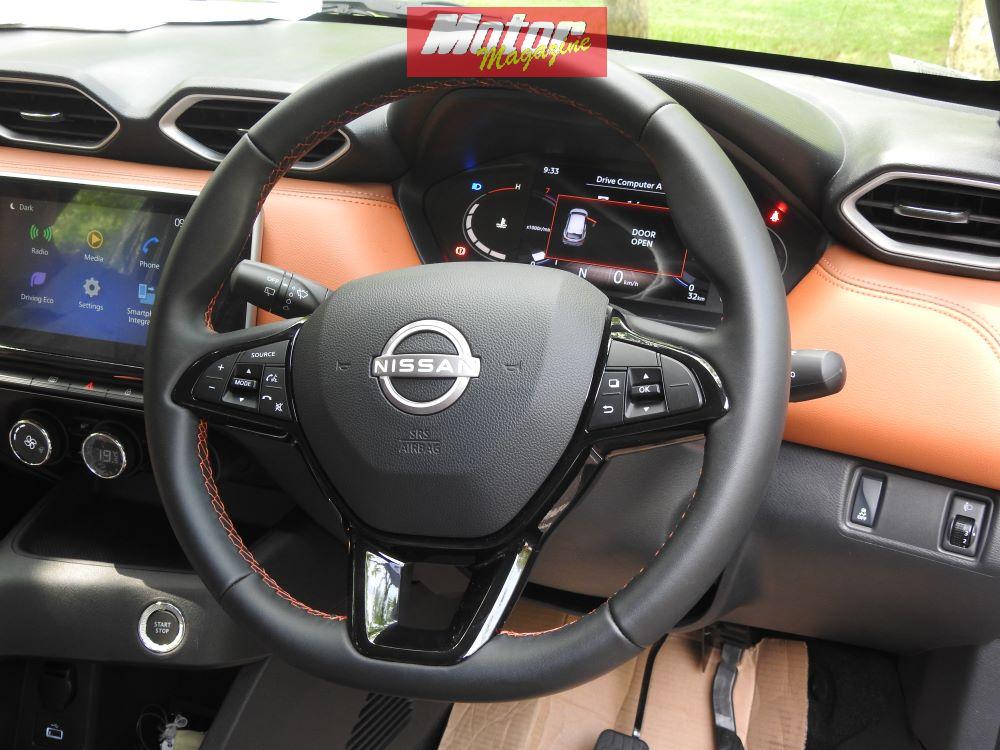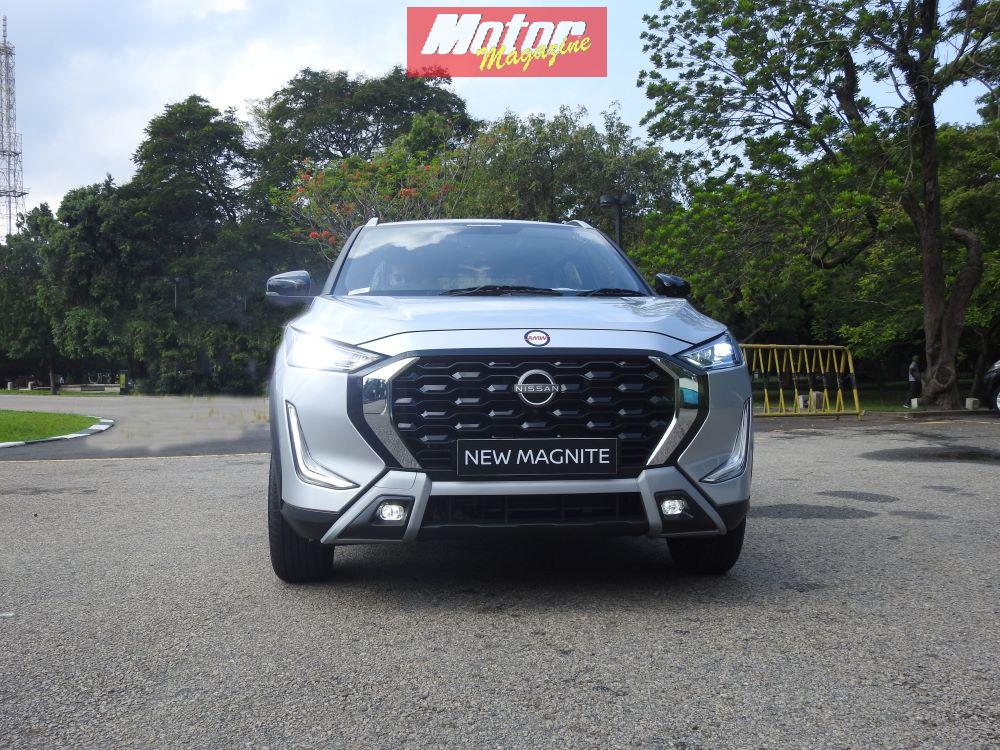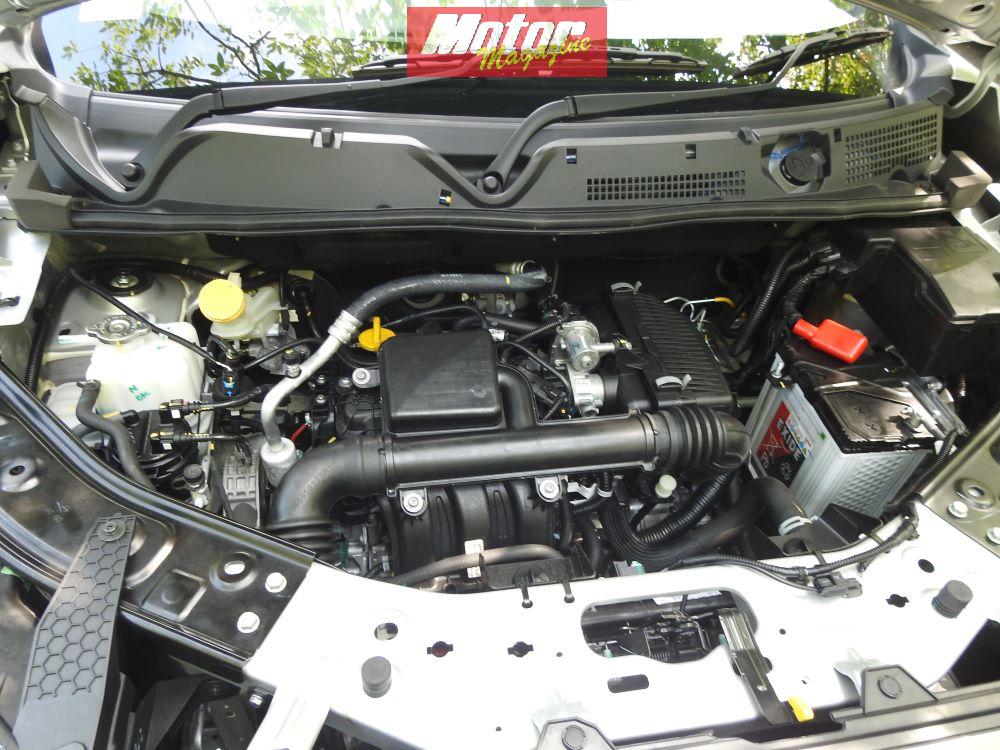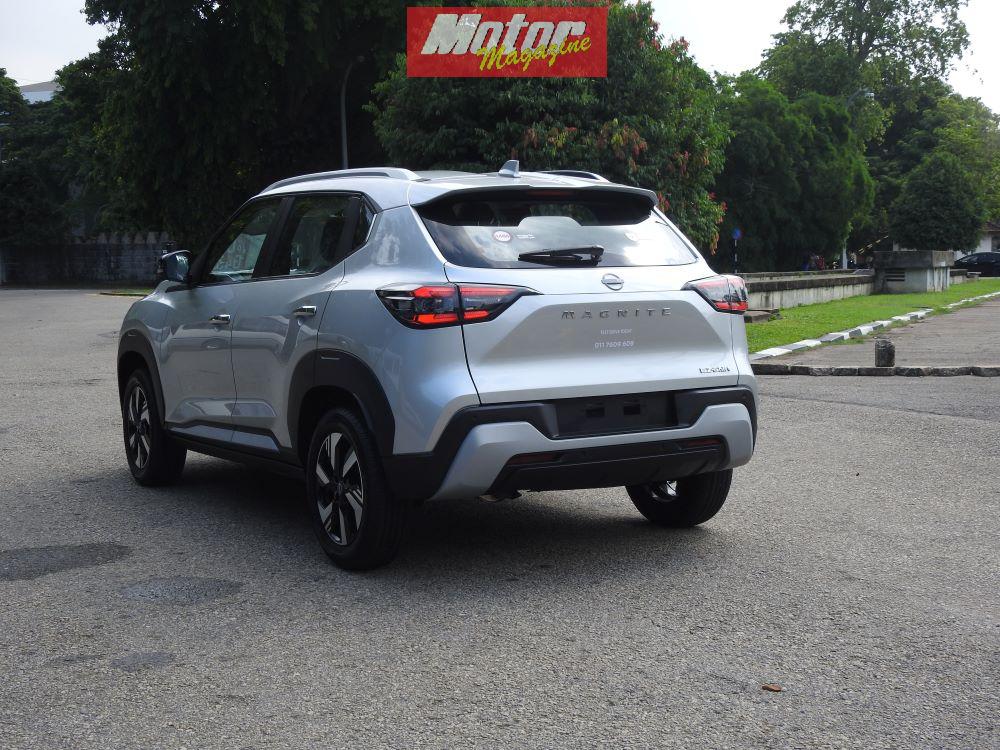The official press release for the Nissan Magnite dated October 21st, 2020 says that the word Magnite is a combination of Magnetic and Ignite. Competing in the crowded sub-4 metre subcompact crossover segment in India, the Magnite has landed to take on the Sri Lankan market. Yes, this vehicle hails from India, as do many of the machines that ply our roads and grace showrooms in 2025. You’d be surprised to hear that even certain luxury brands bring products from…India. In fact, Indian cars have really upped their game in bucketloads over the five years that we’ve been starved of new cars. So let’s discover what the Magnite offers, with this 2025 Magnite in Tekna+ EZ-Shift form from AMW, and we’ve put it through our paces. Here’s our verdict…
Exterior
Our test Magnite comes in a shade called Blade Silver which makes it look quite handsome, especially when paired with a set of duotone 16-inch alloy wheels. The 2024 facelift of the Magnite included a new front end which is showcased on our test car, and includes a larger front grille with gloss black elements, angular LED daytime running lamps and lower mounted LED foglamps. At the side, the Magnite’s short length is most apparent, since it comes in at just 3.99 metres, but that makes it great to nip around the city and park in tight spaces. It does have a ‘tall-boy’ stance, but it isn’t as prominent as on some other Indian cars from the same segment. Meanwhile, the rear sports new taillamps with updated graphics as part of the facelift. We observe that the brake lamps and reversing lamps are LED but the turn signals use traditional amber-coloured bulbs. Interesting indeed.
Oh, and there’s no shortage of this crossover’s calling card; Magnite. You’ve got a Magnite badge at the rear of course. Then, you’ll find it embossed within the rear taillamp cluster. Moving towards the front, there’s a little design element just ahead of the front door with…you guessed it, Magnite (and Nissan in smaller script above). Meanwhile, the front and rear of the vehicle also feature Nissan’s new, flat-styled logo. There’s really no excuse for forgetting this little thing’s name. The AMW-supplied brochure also tells me about a tasty turbocharged variant, as well as some of the other colours available. Highlights include Vivid Blue, Pearl White and Sunrise Copper Orange. There’s also Storm White, Flare Garnet Red and Onyx Black. Dual-tone colour schemes are available for some trims too.
Mech & Tech
The Magnite is available
in naturally aspirated and turbocharged flavours, both with a 1.0-liter
3-cylinder unit. Our test car has the naturally aspirated powerplant, making
72hp and 96Nm. This unit powers the front wheels through a 5-speed automated
manual transmission (AMT) called EZ-Shift. Steering is via an
electrically-operated rack, while braking is taken care of by front discs and
rear drums. There’s ABS and EBD as standard.

Driving Experience
Upon entering the driving seat, I find the driving position to be quite elevated, but not overtly so. You’ve got great visibility all round, save for the rear window being slightly small, a casualty of the car’s sporty design. The engine is already switched on, and idles away with a characteristic three-cylinder hum. Glancing down, you’ve got an AMT gear shifter with a shift knob that’s seemingly modelled on the design of the unit in the R34 Skyline – black leather sides with a silver strip bisecting, albeit here, the silver strip is more chrome and there’s no leather wrapping. Even though the Magnite isn’t a sporty vehicle, this little thing is a nice touch for those who know about Nissan’s storied past.

Today, we’ve got a near-full load of occupants. My co-presenter on RevMatch, Mahen Makalande is in the passenger seat. Occupying the left rear seat is Mr. Motor; Nimal, comfortably stretched out (more about this in the Living With section). The right rear seat is occupied by the nice gent from AMW who brought the car to our test drive location. So, we’re going to see how this little crossover can fare with four full-grown male adults on board (one is a smidge overweight too – me).
Slide the gear shifter
into D, foot off the brake and give a little gas and away she goes. First
impressions are that the AMT is tuned for smoothness. In fact, I’ll openly say
that during normal driving, this is the best AMT I’ve driven so far. Since an
AMT is basically a manual transmission with a computer-operated clutch, it’s
surprisingly hard to get that computer to control the clutch like a proper
human driver. In most cases, it can seem like a learner driver, letting it off
too hard and feeding it in too fast. However, Nissan has really worked a treat
with the Magnite’s AMT control unit. The most notable improvement is that the
“nodding” sensation that comes when an AMT changes gears is largely banished.
You can feel the gear changing if you really wait and look for it, but
otherwise, the drop in engine revs (and sound) is your primary indicator that
you’ve been shifted up. The digital gauge cluster also displays the current
gear choice.
Of course, the flip side of such smoothness is that gear shifts under enthusiastic driving can be a bit tardy. Bury your foot into the carpet and you’ve got at least a second of lag before the gearbox shifts down – once again, focusing on smoothness rather than urgency. The same is true when you slide the gear shifter into M or Manual mode and call for shifts via the shift knob. This characteristic means that you have to plan your overtakes a bit rather than employing the typical “point and shoot” tactic that you can do with a manual or any other type of automatic gearbox. However, once you’re in the required gear, the engine will willingly rev up beyond 5,000rpm although at that level, its sound is quite noticeable. Anyways, it’s got plenty of torque lower down so you rarely need venture beyond 4,000rpm in regular driving. Mind you, all this is with our complement of four adults, so the sub-1,000 kilo Magnite will definitely feel even peppier if it’s just the driver.
I also noticed that the
gearbox didn’t shift into the highest gear at every little opportunity. For
example, let’s say you’re ‘foot in the carpet’, trying to overtake a dawdler.
However, that driver veers a little bit out of their lane, and you come off the
gas, giving an annoyed ‘parp’ on the Magnite’s rather nice-sounding horn. Said
driver quickly moves back into their lane. Now, you can bury your foot again
and get near-instant response because the gearbox has held the lower gear.
Under full throttle acceleration, it actually waits a bit before shifting up if
the driver abruptly lifts off the throttle.

What about the Magnite’s ride? Well, with four adults on board it’s quite well-judged for Sri Lankan roads. It’s definitely on the firm side, but takes speed humps, sunken manhole covers and rumble strips with a definite ‘rounding over’ of the impact. That gives me confidence that the Magnite will be able to handle Sri Lankan roads quite well, even the less well-maintained ones, and with 205mm of ground clearance, it won’t bottom out unless you take it off-road or try to jump a ridiculously high kerb that even a stock Hilux wouldn’t bother with.
As for braking, there’s
more than enough stopping prowess for this 72-horsepower machine that weighs
under 1,000 kilograms without anyone on board. The pedal feel is well adjudged
and there’s ample bite when needed. All in all, the naturally aspirated Magnite
will be fine for the majority of families with regular drivers who aren’t
petrolheads. For people who want more power, there’s a 100hp turbo variant
available too, and we’ll test that soon.
Living with the Magnite
If there’s anything to
be learned from Indian car buyers, it’s that they are supremely demanding. Long
gone are the days that they would settle for anything and everything. That’s
why cars like the Magnite have to really work hard to earn their salt in the
Indian market. Of course, the benefit of that is that we get a pretty nice
specification set in Sri Lanka. For starters, interior space is crucial for
Indians. After all, the car may be rated to carry five occupants but we know it
will end up carrying more. That’s why the Magnite, despite its sub-4 metre
length, offers impressive front and rear head and leg space. For example, with
Mahen sitting in the front seat set quite far back, Nimal, can easily sit
behind him. Even when the front seat is pushed to its most extreme limit, Nimal
can somewhat squeeze in. Meanwhile, as an example as how far interior design
and spaciousness has progressed, I’m just 5 feet 8 inches in height, but I
can’t sit behind my own driving position in my own 2003 Nissan Sunny N16.
What about build
quality? Well, it’s largely up to par. Things have been put together in a solid
manner and it all feels well screwed (or clipped) together. Yes, if you try to
poke around and look in areas lower down, you’ll perhaps find a rough edge or
panel gap or two, but we’re car testers and we look for these. The average
owner will likely never notice.
Another area I wanted to benchmark the Magnite against my Sunny was air conditioning because it’s got probably the best air conditioning system from an early 2000s Japanese car. Even with the sun at its peak, it can freeze my fingers on the steering wheel if I have the vents angled accordingly. The Magnite didn’t disappoint in this regard. It’s also got automatic climate control and chills the cabin impressively. Since it's an Indian-market car, you’ve also got a PlasmaCluster Ionizer to purify the air, since India faces notably bad air quality at certain times of the year. Adding to its cabin chilling prowess is a set of rear passenger air vents that I really wish my Sunny had, if only for the comfort of my children. I must also call out the air vents for being shaped similar to the units in a high-performance sports car from a certain Italian exotic automaker. Another feature that the Magnite has which I wish my Sunny had, is a cooled glovebox. With a 10-liter capacity, a cooled glovebox is an ideal place to stash your water bottle – something I always forget to bring on test drives and photoshoots and end up dehydrating myself – or spending money on unnecessary carbonated drinks. I’ve since switched to isotonics.
The Magnite’s cabin also
comes with some nice luxury features on our Tekna+ specification. The dashboard
comes with soft-touch leather trim as do the door cards which really uplifts
the ambiance of the interior. The seats feature dual-tone leather upholstery
and the brochure tells me that they offer 40% better cushioning balance, with
better bolstering, thigh and spine support. There’s even a thing called Heat
Guard Tech that offers UV resistance and reflects heat away from the surface.
As someone with leather upholstery in my Sunny, I know how painful it can be to
return to the car after it’s been parked in the sun for some hours. I couldn’t
test out this tech properly, but I noted that the seats felt quite cool even
after we had parked the car in the sun, albeit for a few minutes.

What about infotainment? Well, you’ve got an 8-inch touchscreen for control, with wireless Apple CarPlay and Android Auto. Of course there’s good old FM radio, as well as a USB input for a pen drive filled with tunes of your choice. The sound system in our test car was a generic one and I counted six apertures (one speaker in each door, and one on either side of the top of the dashboard). Sound quality is adequate for most listeners, but the discerning will definitely want to upgrade. Then again, at this price point you can’t really expect studio or theatre quality, can you? The driver also gets a 7-inch digital gauge cluster with various display modes.
Finally, cargo space. Firstly,
let’s talk about in-cabin storage. Here, the Magnite is claimed to have 19
litres of interior storage space. This includes the 10-litre cooled glove box,
centre console, front arm rest compartment and door pockets. You also get four
cup holders and a helpful tray above the front USB port that can accommodate a
large smartphone. Then, we get to the boot. With the rear seats up you’ve got 336
litres of space. You can expand this to 690 litres by folding down the rear
seat backs. There’s also a removable parcel shelf that can be installed to keep
your cargo area truly separate from the passenger cabin – ideal for those days
when you’re returning from the fish shop!
Safety
We counted six airbags inside the Magnite’s cabin which is par for the course and offers ample protection for all occupants. The brochure also tells me that the car has got traction control, electronic stability control and brake assist. Interestingly, the car also comes with a 360-degree around-view monitor which uses four cameras to stitch a composite image of the surrounding area. While this is a nice feature, I feel that it’s not really necessary in such a small and easily manoeuvrable vehicle. Perhaps Nissan could instead fit a higher resolution reverse camera instead, as I felt that the reverse camera resolution was insufficient. Surely an HD camera would have been more suitable.
Fuel Economy and Price
We reset the trip meters
and drove normally for about 15km in Colombo traffic (not peak traffic but
average weekday traffic). Here, we noted around 10km/l on the trip computer,
with four occupants on board, regular (not conservative) driving, and air
conditioning set to 20 degrees. If you travel with less people, have a very
careful right foot and don’t mind suffering in the heat you can do better. But
why? Why suffer among the stresses, trials and tribulations of life for maybe
1km/l more? Of course, on the highway you can expect at least 15 km/l (the
official figures for the Magnite in India is around 18 km/l for automatics;
manuals can nearly touch 20 km/l).
Price is where things
get really interesting. The base spec Accenta EZ-Shift comes in at 7.8 million
but you do miss a lot of nice things. A Tekna+ spec EZ-Shift car like our
tester is priced at 8.9 million. Then, we move into the Turbo CVT realm. Here,
the N-Connecta is 9.5 million and the Tekna+ comes in at 9.9 million. All
prices are correct at the time of writing (May 2025), and include VAT, we’re
told. The warranty for the vehicle is 3 years or 100,000 kilometres (whichever
occurs first).

Final Words
The 2025 Magnite sits in
an interesting place in terms of pricing. At the time of writing, there isn’t
really a competitor in this price point. It’s a tempting upgrade point for
those with cars like WagonRs, Vitzes and Altos who want to stay beneath the
10-million-rupee price point – and I can’t believe that 10 million rupees has
become a ‘low’ price for cars.
With the Magnite you do
get a lot of car for your money, and it’s definitely worth a test drive. Since
they’ve got the NA and Turbo variants on offer, you should test-drive both and
see which one suits your fancy.




.jpg)